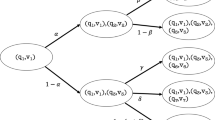Abstract
Attempts to lay a foundation for the sciences based on modern mathematics are questioned. In particular, it is not clear that computer science should be based on set-theoretic mathematics. Set-theoretic mathematics has difficulties with its own foundations, making it reasonable to explore alternative foundations for the sciences. The role of computation within an alternative framework may prove to be of great potential in establishing a direction for the new field of computer science.
Whitehead's theory of reality is re-examined as a foundation for the sciences. His theory does not simply attempt to add formal rigor to the sciences, but instead relies on the methods of the biological and social sciences to construct his world-view. Whitehead's theory is a rich source of notions that are intended to explain every element of experience. It is a product of Whitehead's earlier attempt to provide a mathematical foundation for the physical sciences and is still consistent with modern physics.
A computer simulation language is, in fact, a theory of reality; one that is often based on extremely simplistic notions. Simulation languages have evolved from the various programming languages and not from the development of their underlying world-view. The use of an established theory of reality, such as Whitehead's, as the basis of a simulation language is proposed as a way of extending the usefulness of computer simulation as an experimental tool for the theory.
The λσ simulation language is a first step in this direction. Based on Whitehead's notion of concrescence and a formalization in the typed λ-calculus, λσ provides a notation and method for the construction and simulation of real-world phenomena. Both philosophy and computer science stand to benefit from such an attempt. Whitehead's theory gains a testing tool, while computer science gains a significantly more advanced simulation language.
Similar content being viewed by others
References
Bates, J. and Constable, R.: 1985, ‘Proofs as Programs’,ACM Transactions on Programming Languages 7, 113–136.
Beeson, M.: 1985,Foundations of Constructive Mathematics, Springer-Verlag, New York.
Bernays, P. and Fraenkel, A.: 1958,Axiomatic Set Theory, North-Holland, Amsterdam.
Bishop, E.: 1967,Foundations of Constructive Analysis, McGraw-Hill, New York.
Bishop, E.: 1970, ‘Mathematics as a Numerical Language’, inIntuitionism and Proof Theory, North-Holland, Amsterdam.
Churchman, C.: 1968,The System Approach, Dell, New York.
Code, M.: 1985,Order and Organism, State University of New York Press, Albany, NY.
Constable, R.: 1986,Implementing Mathematics with the Nuprl Proof Development Systems, Prentice Hall, Englewood Cliffs, NJ.
Dahl, O.: 1966, ‘SIMULA — An ALGOL-based Simulation Language’,Communications of the ACM 9, 671–678.
Dijkstra, E.: 1976,A Discipline of Programming, Prentice Hall, Englewood Cliffs, NJ.
Forrester, J.: 1968,Principles of Systems, MIT Press, Cambridge, MA.
Garey, M. and Johnson, D.: 1978,Computers and Intractability: A Guide to the Theory of NP-Completeness, H. Freeman, San Francisco.
Greenspan, D. and Casulli, V.: 1985, ‘Particle Modelling of an Elastic Arch’,Applied Mathematical Modelling 9, 215–219.
Greenspan, D.: 1989, “Particle Simulation of Biological Sorting on a Supercomputer’,Computers Math. Applic. 18, 823–834.
Heyting, A.: 1956,Intuitionism, an Introduction, North-Holland, Amsterdam.
Johnson, A.: 1962,Whitehead's Theory of Reality, Dover, New York.
Kortright, E.: 1991, λσ:A Forma. Method for Simulation Based on the Typed λ-Calculus, Ph.D. dissertation, Center for Advanced Computer Studies, Lafayette, LA.
Kortright, E.: 1990, ‘λσ: A Simulation Language Based on the Typed λ-Calculus’,Advances in Modelling and Simulation 25, 13–23.
Kortright, E.: 1991, ‘Particle Simulation in λσ’, inProceedings of the 1991 Summer Computer simulation Conference, Society for Computer Simulation, Baltimore, MD, pp. 110–114.
Kortright, E.: 1991, ‘Parallel Simulation in λσ’, inProceedings of the 1991 Simulation Technology Conference, Society for Computer Simulation, Orlando, FL, pp. 356–361.
Kreutzer, W.: 1986,System Simulation, Programming Styles and Languages, Addison-Wesley, New York.
Lakatos, I.: 1976,Proofs and Refutations, Cambridge University Press, Cambridge, MA.
Lango, J.: 1972,Whitehead's Ontology, State University of New York Press, Albany, NY.
Lebel, J.: 1985, ‘System Dynamics’, in Cellier, F. (Ed.),Progress in Modelling and Simulation, John Wiley, New York, pp. 119–158.
Levin, L.: 1989,Elements of the Theory of Computation, unpublished manuscript, Boston University, Boston, MA.
Martin-Löf, P.: 1975, “An Intuitionistic Theory of Types: Predicative Part’, in Rose, H. and Shepherdson, J. (Eds.),Logic Colloquium, pp. 73–118, Elsevier North-Holland, New York.
Martin-Löf, P.: 1985, “Constructive Mathematics and Computer Programming’, in Hoare, C. and Shepherdson, J. (Eds.),Mathematical Logic and Programming Languages, Prentice-Hall, Englewood Cliffs, NJ.
Moore, G.: 1982, ‘Zermelo's Axiom of Choice: Its Origins, Development, and Influence’, inStudies in the History of Mathematics and Physical Sciences, Vol. 8, Springer, New York.
Negoita, C.: 1985,Expert Systems and Fuzzy Systems, Benjamin Cummings, Menlo Park, CA.
Nilsson, N.: 1971,Problem-Solving Methods in Artificial Intelligence, McGraw-Hill, New York.
Pritsker, A.: 1984,Introduction to Simulation and SLAMII, Halstead Press, New York, 2nd edition.
Pugh III, A.: 1973,DYNAMO II User's Manual, MIT Press, Cambridge, MA.
Randers, J.: 1980,Elements of the System Dynamics Method, MIT Press.
Robbin, J.: 1969,Mathematical Logic, W. A. Benjamin, Inc., New York.
Schriber, T.: 1974,Simulation Using GPSS, John Wiley, New York.
Sherburne, D. E.: 1966,A Key to Whitehead's Process and Reality, University of Chicago Press, Chicago.
Thom, R.: 1986, ‘„Modern” Mathematics: An Educational and Philosophic Error?’ in Tymoczco, T. (Ed.),New Directions in the Philosophy of Mathematics, Birkhäuser, Boston, MA.
Ullam, S.: 1986,Science, Computers and People, Birkhäuser, Boston, MA.
Whitehead, A.: 1958,Modes of Thought, Capricorn Books, New York, 1958.
Whitehead, A.: 1960,Process and Reality, MacMillan, New York.
Whitehead, A.: 1965,A Philosopher Looks at Science, Philosophical Library, New York.
Author information
Authors and Affiliations
Additional information
In philosophical discussion, the merest hint of dogmatic certainty as to the finality of statement is an exhibition of folly. A. N. Whitehead,Process and Reality.
Rights and permissions
About this article
Cite this article
Kortright, E.V. Philosophy, mathematics, science and computation. Topoi 13, 51–60 (1994). https://doi.org/10.1007/BF00763648
Issue Date:
DOI: https://doi.org/10.1007/BF00763648




